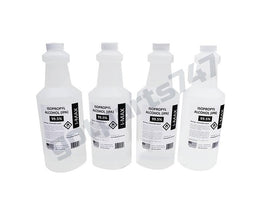Is your phone screen a bit grimy? Or have you done some soldering on that gaming PC you’re building? Learn how you can safely use isopropyl alcohol to clean your electronics – and when you should opt for another solution.
Cleaning electronics with isopropyl alcohol (IPA) can seem like a simple task – just wipe, swipe, and give it a moment to dry. But electrical gadgets are notoriously delicate. What components can be safely cleaned with IPA? When should you use a milder vs. a stronger solution?
First, let’s talk about what IPA is and how it’s different from some other cleaning agents.
IPA vs. Ethanol vs. Acetone
Isopropyl alcohol is made from a chemical process that combines water and propene and then distills it to a given strength, usually from 60-99 percent. (The higher the percentage, the less water is contained in the mixture. The common 70% isopropyl alcohol you buy in a drug store is 30% water.) It has a strong smell, evaporates quickly, and is well-known as a sanitizer, disinfectant, and cleaning agent.
Ethanol or ethyl alcohol is made from fermenting sugars (just like beer or wine). It’s not the same as IPA; you can see our earlier comparison of denatured alcohol vs. isopropyl alcohol for a more detailed explanation. As a rule, IPA is preferred over ethanol for cleaning electronics because it evaporates cleanly and doesn’t leave behind any potentially harmful residue.
Acetone is the active ingredient in paint thinner and nail polish remover. It’s an excellent solvent, but it can be too strong for electrical connections and components. Although some commercial electronic cleaners contain a very small amount of acetone, it’s best not to use it by itself. After all, it can melt plastic if you’re not careful.
Water and vinegar are a popular and non-toxic cleaning solution for phone, tablet, and TV externals. However, it’s best to apply the solution to a cloth and then wipe the cloth on the surface of your gadget; this way, you can avoid exposing these sensitive devices to too much water. It’s also worth noting that this solution only cleans surfaces (i.e. removes fingerprints and smudges). It doesn’t kill germs like IPA does.
Why Use Isopropyl Alcohol to Clean Electronics?
IPA, especially in the higher concentrations, is commonly used to clean electronic components during the manufacturing process. It’s also a go-to solution for many professionals. This is because isopropyl alcohol:
- Sanitizes surfaces. IPA kills bacteria and viruses, but it needs some time to do so. This is why lower concentrations (between 60-70 percent) are preferred for sterilization; they have a slower evaporation rate and a longer dwell time (i.e. the time the alcohol is in contact with the surface).
- Quickly evaporates. As mentioned in the previous point, higher concentrations of IPA evaporate very quickly and leave no residue – perfect for cleaning water-sensitive electronic elements.
- Dissolves oils, adhesives, and more. It’s very common to see experts recommend using IPA to remove flux residue (from soldering) as well as oil, grease, and adhesive residue. It’s a powerful solvent, but unlike some others, it dries quickly and cleanly. Technicians usually choose this because it shortens their work cycle – less time is spent waiting for the component to dry. This is also a safety factor, as we’ll see in a moment.
- May remove or prevent water corrosion damage if applied correctly. This is getting into the expert realm, though, so be sure you completely understand the process before you try it.
How to Safely Clean Electronics with Isopropyl Alcohol
You can use 70%, 91%, or 99% isopropyl alcohol to clean various types of electronics – what you choose will depend on what you’re cleaning. For externals – such as disinfecting your smartphone or TV remote – 60-70 percent will do a better job. The purer higher concentrations are better for removing grime and debris from water-sensitive areas. If, for example, you’re working near a computer motherboard, the lower water amount in 90-99% IPA will prevent even the chance of impurities harming delicate circuitry.
However, not all parts of your electronic equipment should be swabbed with strong IPA solutions. And, as you’re working with a flammable and toxic chemical, you’ll want to take proper safety precautions:
- Work in a well-ventilated area.
- Avoid flames and sparks, as IPA (and its vapors) are very combustible.
- Use proper safety equipment if you’re working with highly concentrated isopropyl alcohol solutions.
- Make sure your device is powered off and unplugged before you start to clean it.
- Apply IPA sparingly; use the least amount that effectively does the job.
- Allow cleaned components to dry completely before putting them back together or plugging them in.
Here are specific recommendations for different types of electronic devices:
- Smartphones, tablets, and computer monitors: Avoid applying anything liquid to the speaker, microphone, camera, and screen area.As mentioned earlier, the best approach is to spray a cleaning cloth and then wipe the device with the cloth. Avoid using IPA directly on the screen, as some manufacturers add an oil-repellent coating to the screen that can be damaged by it. A 50/50 vinegar and water solution is better for touchscreens; just apply it to the cloth as described above.
- TVs: If possible, use a damp cloth and a dry microfiber cleaning cloth to remove smudges from your TV. If that doesn’t work, use the vinegar and water mixture in the same way as you would for a touchscreen.
- Media equipment (DVD/Bluray players, DVRs, Roku boxes, remote controls, etc.): Clean the plastic housing with 60-70% isopropyl alcohol.
- Keyboards, mice, game controllers, etc.: Clean with 60-70% IPA as described above.
We always advise cleaning electronics with the smallest amount of isopropyl alcohol necessary. It’s usually best to avoid directly spraying the device with alcohol. If you follow the proper precautions, you can safely and effectively clean your electronic equipment with IPA.

